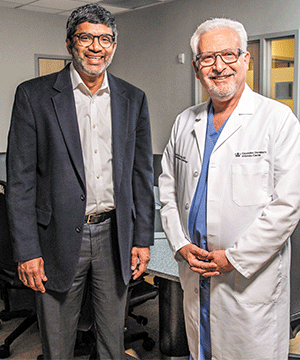Structural Heart Disease

Dr. Susheel K. Kodali and Dr. Martin B. Leon
“With the PARTNER 3 clinical trial demonstrating that transcatheter aortic valve replacement performs better than open-heart surgery in patients with severe aortic stenosis at low surgical risk, TAVR has been established as the dominant therapy for aortic stenosis,” says Martin B. Leon, MD, Director of the Center for Interventional Vascular Therapy at NewYork- Presbyterian/Columbia University Irving Medical Center, and Principal Investigator of the trial.
“With the great successes of TAVR, transcatheter therapies are emerging for other types of structural disease,” adds Susheel K. Kodali, MD, Director of the Structural Heart and Valve Center at Columbia. “These include asymptomatic aortic stenosis, bicuspid aortic valve disease, and aortic regurgitation, as well as disorders of the mitral and triscuspid valves. Columbia faculty are taking the lead investigating new, less-invasive approaches to address these conditions.”
EARLY TAVR “The achievements of TAVR encouraged us to think about providing therapy before the onset of significant symptoms,” says Dr. Leon. He and his colleagues are in the third year of EARLY TAVR, a randomized trial led by investigators at Columbia University comparing outcomes of watchful waiting to earlier treatment in aortic stenosis to help determine the optimal time to intervene.
Addressing Aortic Stenosis and Regurgitation The JenaValve is designed to treat symptomatic, severe aortic stenosis and aortic regurgitation using a single valve prosthesis. “Unlike other TAVR designs, this technology allows transcatheter replacement in a patient with pure aortic regurgitation,” says Dr. Leon. “Along with our colleagues at MedStar Washington Hospital Center, we led the initial U.S. clinical trial evaluating the use of JenaValve in high risk patients with either aortic stenosis or aortic regurgitation. Initial results have demonstrated excellent hemodynamics and superior paravalvular leakage results.”
Replacing the Mitral Valve “The mitral valve has proven a lot more challenging than initially thought,” notes Dr. Kodali. “We are involved in trials looking at feasibility of transcatheter replacement. The Medtronic Intrepid valve, currently being studied in the APOLLO trial, is a self-expanding stent with an integrated tissue valve designed to be inserted via a catheter. Currently the device is inserted from an incision in the chest wall from the apex.” Dr. Kodali and Vinayak Bapat, MD are helping to lead the development of a transseptal delivery system that would allow transcatheter delivery of the Intrepid valve from the femoral vein with a fully percutaneous approach. It is anticipated that the transseptal version will be rolled into the main trial.
Devices for Heart Failure Two new therapies are being investigated by Columbia researchers as an intermediate solution between medical therapy and ventricular assist devices. “AccuCinch is a device consisting of a series of connected anchors placed percutaneously that can be cinched to help remodel the left ventricle in patients with heart failure and reduced ejection fraction,” explains Dr. Leon. “This device is now in early feasibility studies. The second study is a pivotal clinical trial for an interatrial shunt device for patients with heart failure and preserved ejection fraction. When you have heart failure, the pressures in the left side of the heart are elevated. We are now studying if the placement of a shunt between the left and the right atrium will help balance the pressure levels and reduce symptoms.”
Left Atrial Appendage Closure This procedure eliminates the need for long-term oral anticoagulation in patients with atrial fibrillation and is emerging as a strategy for stroke prevention. The Left Atrial Appendage Closure Team at Columbia is directed by Robert J. Sommer, MD, who recently performed the first human case using the Conformal Left Atrial Appendage (LAA) Seal. The case served to initiate a multicenter study investigating the effectiveness of LAA occlusion with the Conformal device for prevention of stroke in patients with AFib.



